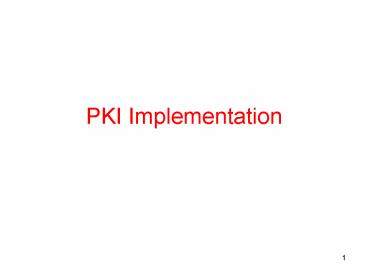PKI Implementation - PowerPoint PPT Presentation
1 / 13
Title: PKI Implementation
1
PKI Implementation
2
PKI Implementation
- User names and PKI
- Trust
- Authorization
- Revocation
- Keys and PKI
3
User names and PKI
- PKI does not attempt to associate username with a
unique individual - Only choice available is the email or screen name
for identification - One individual may have multiple email / screen
names - Government issued identities such as Social
Security Number are restricted in usage
4
User names and PKI
- Certificate Authority assigns unique names
- CA also provides verification
5
Trust
- PKI enables key management for cryptography
- PKI relies on the trustworthiness of the CA
- Cryptography emphasizes trust for key exchange
6
Authorization
- Currently users are given userIDs and a separate
method of assigning access privileges controls
permissions - One way to control permissions is via Access
Control Lists (ACL) - ACL is a database table and consequently could be
the target of an attack - Direct authorization means userIDs are given the
necessary privileges
7
Authorization
- Credentialing is another way to provide
authorization - Credentialing enables time-based authorization
- Credentialing could be cumbersome in online
validation of certificates
8
Revocation
- CA revokes certificates based on
- User request (possibly lost key)
- Failure to follow policies
- Employee left the organization
- Users should be educated to check for revocation
- Revocation involves
- Reliability
- Speed
- Revocation system should be dynamic
9
Revocation
- Certificate Revocation List (CRL) should be
accessible by all users - Lack of a universal CA limits the use of CRL
- Central CRL (such as the central pool of
toll-free numbers) could facilitate CRL use - Preferred solution is a distributed CRL system
- Alternative to revocation is fast expiration such
as certificates that expire in 10 minutes
10
Keys and PKI
- Key server could perform the role of PKI
- Key server has some disadvantages
- Key server must be available all the time for
validation - PKI, because of CRL and expiration, does not have
to be available all the time - Key server is centralized by its very nature
- PKI uses certificates used by CAs by other
validation means
11
Keys and PKI
- PKI provides non-repudiation
- The root key of CA need not be online for
authentication or verification - PKI is more complex than a key server system
- Key servers are well suited for small systems
- PKI is well suited for large systems
12
Keys and PKI
- http//www.cs.auckland.ac.nz/pgut001/pubs/x509gui
de.txt - For PKI to work efficiently we may need something
like XML to interpret data - XML allows multiple representations of data to
bring to the web - CA should be able to use a language that the
sub-CAs understand and which is present in the
certificate
13
Keys and PKI
- Alice generates the public/private key and shares
the public key with the CA who validates Alice - CA distributes the public key
- Keys should have a passive use time with
reference to expiration of key































